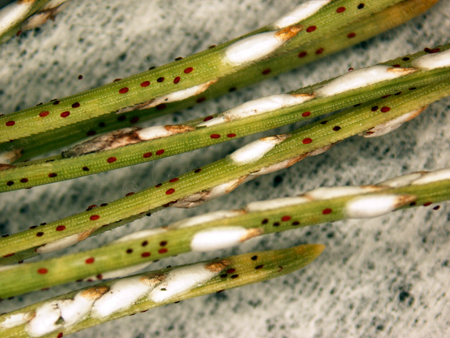Introduction
Pine needle scale (Chionaspis pinifoliae), also referred to as white scale, is a tiny armored insect that infests various species of pine. The insect is notable for the distinct wax covering the adults produce to conceal their eggs. Severe infestations can cripple host trees, causing significant foliar dieback, and reducing tree vigor.
Distribution & Habitat
Pine needle scale is distributed throughout North America. It is most common in the northern United States, and southern Canada.
Hosts
Pine needle scale attacks a slew of hosts, including Austrian, eastern white, mugo, red, and Scots pine. Scots pine is especially prone to infestation. Infestations of pine needle scale also occur on Douglas-fir, eastern red cedar, and spruce, albeit with less frequency.
Description
Pine needle scale passes through four stages during its life cycle: an egg stage, a larval stage, a pupal stage, and an adult stage. The eggs are oval shaped, and colored a deep crimson red. They are laid in clusters beneath waxy covers secreted by the females. The waxy covers are white with a yellow tip located at the anterior. Each cover extends up 3.0 mm in length. Newly hatched nymphs, or crawlers, are light purple to reddish brown, and oval shaped. The crawlers turn yellow as they mature. Immature crawlers have mouthparts that they use to feed. Adult females measure around 3.0 mm long. They have flattened bodies, which are tan to dark orange, and are absent of legs and wings. Similar to immature crawlers, females have piercing mouthparts that are employed for feeding. Male scale insects are similar in coloration to the females, but smaller in stature, measuring close to 1.0 mm in length. They lack mouthparts, but feature a set of wings that protrude out from their backs, enabling them to fly short distances.
Life Cycle
Pine needle scale produces two generations per year: one in spring, and one in summer. Clusters of up to 40 eggs overwinter beneath the waxy covers established by the females. In mid to late May, the eggs hatch, revealing masses of crawlers. Nearly all eggs of the spring generation hatch within 5 to 7 days. Once liberated, the crawlers navigate over the needles for a few days, before settling down to feed. The crawlers insert their mouthparts into the needles, and commence feeding, consuming sap, and other plant liquids. After initiating feeding, the crawlers brighten in color, turning yellow. Upon feasting for a week, the crawlers molt into second stage instars. This phase of their development is called the hyaline stage. As the crawlers continue to feed, they excrete the white, waxy material that forms the armored cover.
After feeding for 6 to 8 weeks, the crawlers mature, becoming males or females. The males navigate to the females to mate. Shortly after mating, the males expire. The females lay their eggs on the infested branches, and in bark crevices. This represents the second generation of eggs. The eggs hatch in mid-July, with the crawlers continuing to emerge over the following two to four weeks. The newly hatched crawlers move onto the expanding shoots, and feed primarily on the current year needles. By September, the second generation of crawlers matures. The adults mate, and the females lay eggs under the waxy covers. The eggs overwinter until the following spring, whereupon they hatch, beginning the cycle anew.
Symptoms of Infestation
The feeding of the crawlers causes the needles of infested trees to become discolored. Infested needles will turn yellowish-brown in the area surrounding each sessile scale. When trees are heavily infested, needles, shoots, or entire branches may die back. Significant foliar dieback can reduce the growth rate of the tree. This often results in affected trees developing sparse sections of the crown, which detracts from their overall appearance. Trees that have been weakened by pine needle scale are also predisposed to invasions from disease pathogens, and other insects. The foliage of severely infested trees may appear gray or white-washed, due to the prevalence of waxy coverings on the host’s branches.
Management
- Registered insecticides may be applied during the growing season to combat the two generations of crawlers that develop. Initial applications should begin in May, with subsequent applications performed from mid-July to August at three to four week intervals.
- When the crawlers are stationary, they become vulnerable to several natural predators, including lady beetles and wasp parasitoids. The life cycle of two species of lady beetle, the twice-stabbed ladybird, and Microweisia misella, is synchronous with that of pine needle scale. When present, these two species of lady beetle may drastically limit crawler populations. Wasp parasitoids implant the scale with their eggs. As the eggs hatch, the larvae feed on the scale from within, eventually killing them. Once a wasp has completed its development, it gnaws a round hole in the white armor, and emerges, leaving behind the husk of the scale insect.
- Horticultural oils can be utilized to smother the insects. This method will not harm any beneficial insects, and is safe for application to organically grown crops.
Additional Resources:
http://msue.anr.msu.edu/uploads/files/e2812.pdf
http://ento.psu.edu/extension/factsheets/pine-needle-scale
Photo courtesy of Howard Russell.


